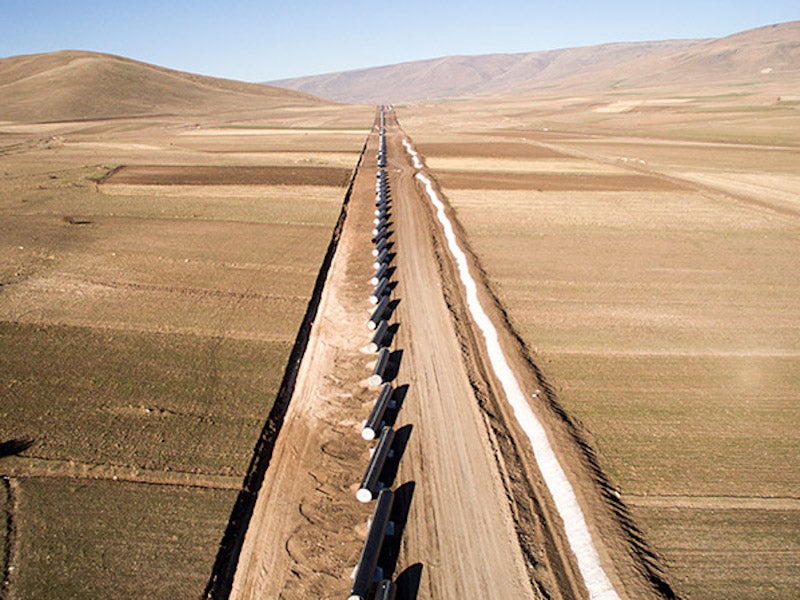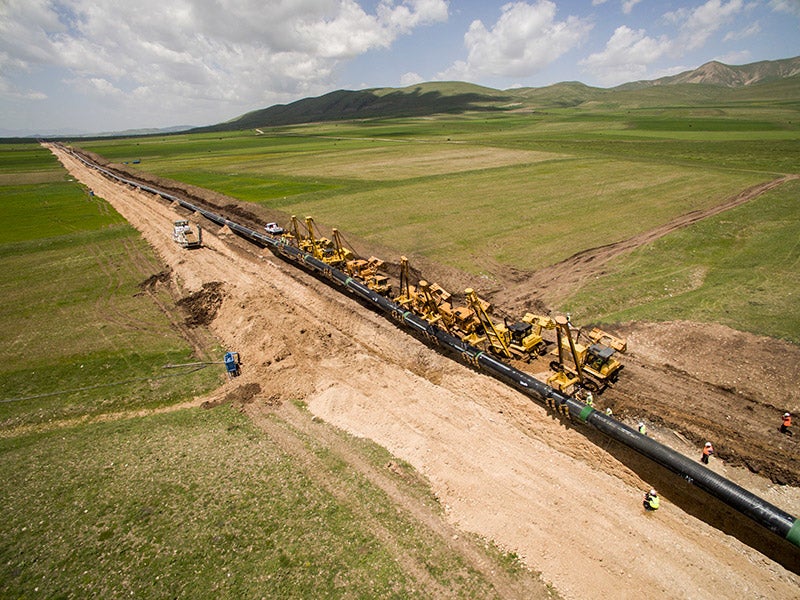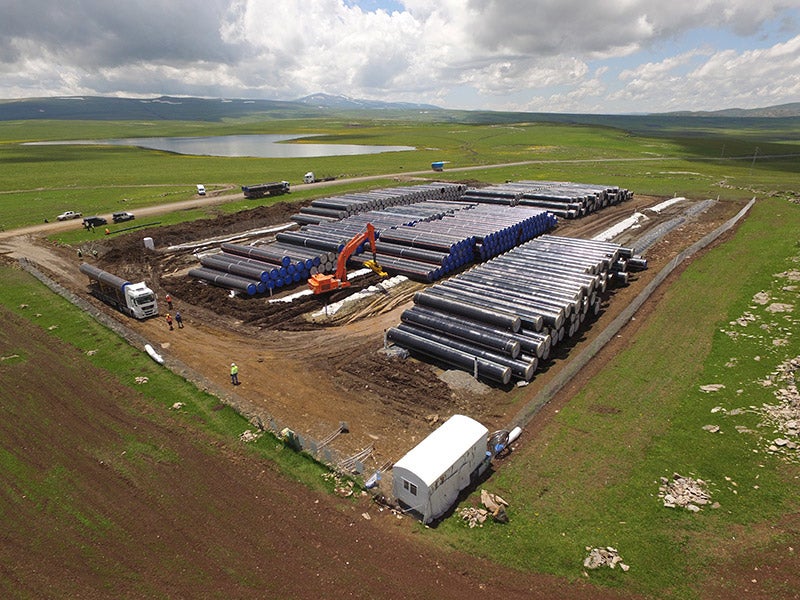The Trans Anatolian Natural Gas Pipeline (TANAP) is a 1,850km-long pipeline that runs from the Ardahan province in eastern Turkey to the Edirne province in western Turkey. It forms a key section of the Southern Gas Corridor to transport natural gas from Azerbaijan to Europe.
TANAP is connected to the South Caucasus Pipeline (SCP) that brings the natural gas produced at the Shah Deniz-2 field in Azerbaijan’s Caspian Sea up to the Georgia-Turkey border. It will deliver gas to Europe by connecting the Trans Adriatic Pipeline (TAP) that originates at the Greek-Turkish border.
The Southern Gas Corridor Closed Joint Stock Company (SGC) holds a 51% interest in TANAP. The other partners are Turkey’s state pipeline operator Botas (30%), BP (12%), and SOCAR Turkey Energy (7%). Southern Gas Corridor is a joint venture between Azerbaijan state oil company SOCAR (49%) and the Ministry of Economy of the Republic of Azerbaijan (51%).
The construction of the £5.5bn ($7bn) TANAP project was started in March 2015 while the pipeline section from the Turkey-Georgia border to Eskisehir entered service with the commissioning of the Shah Deniz-2 field in June 2018.
The construction of the TANAP project was fully completed in June 2019.
Trans Anatolian Pipeline route and design details
The 1,850km pipeline originates in Posof district in the Ardahan province near Turkey’s border with Georgia and passes through 20 provinces in Turkey before terminating in Ipsala district in the Edirne province near the Turkey-Greece border.
The pipeline comprises two off-take stations, two compressor stations, four metering stations, 11 pigging stations, and 49 block valve stations along its route. The diameter of the majority section of the pipeline is 56in.
The off-take stations in Eskisehir and Thrace receive gas from the TANAP and supply to Turkey’s national natural gas network.
The pipeline runs for 1,337km from Posof to Seyitgazi in the Eskisehir province. The diameter of the Posof -Seyitgazi section is 56in.
The Seyitgazi-İpsala section runs for 459km and comprises 48in-diameter pipelines, while the 17.6km-long and 36in-diameter twin pipelines section of TANAP passes underneath the Dardanelles Strait in the Sea of Marmara.
TANAP gas delivery capacity
The initial transmission capacity of the pipeline is 16 billion cubic metres (bcm) of natural gas a year. Turkey receives 6bcm a year, while the remaining 10bcm is meant for transportation to customers in Europe via the Trans Adriatic Pipeline.
The capacity of the pipeline can be expanded to 31bcm a year with the installation of five additional compressor stations along its route.
TANAP project financing
The Asian Infrastructure Investment Bank (AIIB) agreed to provide a loan of £485m ($600m) for the TANAP project in December 2016, while the World Bank approved a loan of £647m ($800m) in the same month.
The European Bank for Reconstruction and Development (EBRD) agreed to provide a loan of £378m ($500m) for the project in October 2017 and the European Investment Bank (EIB) approved a loan of £826m ($1.15bn) for the project in March 2018.
Southern Gas Corridor
Southern Gas Corridor which covers a distance of approximately 3,500km comprises the South Caucasus Pipeline, TANAP, and the Trans Adriatic Pipeline. TANAP is the longest section of the Southern Gas Corridor.
The 692km-South Caucasus pipeline passes through Azerbaijan and Georgia before connecting to TANAP at the Georgia-Turkey border. The length of the pipeline in Azerbaijan and Georgia is 443km and 249km respectively.
As part of the Shah Deniz 2 development, the South Caucasus pipeline was expanded by constructing a new 48in pipeline loop in Azerbaijan and Georgia over a length of 424km and 63km respectively. Two new compressor stations were also built as part of the expansion. The transmission capacity of the South Caucasus pipeline is approximately 23bcm a year.
The 878km-long Trans Adriatic Pipeline which is currently under-construction passes through Greece, Albania, and Italy. It is connected to TANAP at the Turkey-Greece border. The initial transmission capacity of the pipeline is 10bcm a year and can be increased up to 20bcm a year with additional compressor stations.
Contracts awarded for the Trans Anatolian Pipeline
The entire TANAP pipeline construction was divided into four sections or lots. The contracts for lots 1, 2, and 3 were awarded in December 2014.
Fernas Construction bagged the contract for the lot 1 pipeline construction that involved the 56in-diameter and 375km-long section of the pipeline from Posof to Askale in Erzurum province.
A consortium of Sicim, Yuksel, and Akkord won the contract for the lot 2 pipeline construction that included the 56in-diameter and 450km-long section from Askale in Erzurum province to Yildizeli in Sivas province.
Tefken Construction and Installation Company was selected for the lot 3 pipeline construction comprising the 56in-diameter and 509km-long section from Yildizeli in Sivas province to Seyitgazi in Eskisehir province.
A joint-venture between Punj Lloyd and Limak was awarded a contract for the lot 4 pipeline construction in January 2016. It included the 48in-diameter and 459km-long section that stretches from Eskişehir to the İpsala district in Edirne province at the Turkey-Greece border. The value of the contract was approximately £286m ($409m).
Tekfen Construction received an engineering, procurement, and construction (EPC) contract for two compressor stations and four metering stations along the pipeline in February 2016.
ABB Elektrik Sanayi bagged an EPC contract for the SCADA/Telecommunications system for the project in October 2015.
Baosteel Europe, Toscelik, a consortium of Borusan Mannesmann, Noksel and Erciyas, and a consortium of Umran Boru and Emek Boru were selected to manufacture and supply mainline pipes for the project in October 2014. The length of each steel pipe is approximately 13m.





